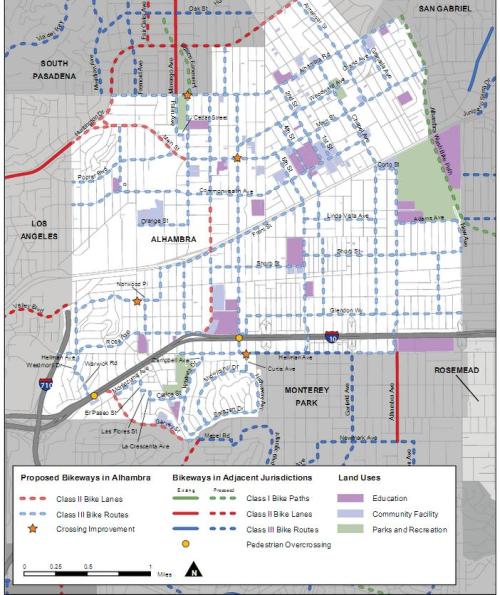Posted in bicycling, tagged sharrows on November 22, 2012|
19 Comments »
Once upon a time, sharrows might have seemed like a good idea for special situations. But now they are a way for communities to do “pretend” bike plans. Just stripe a bunch of sharrows on streets and voila! we have a bike network — without having to make messy political compromises on parking and lane removal. A great way for city councils to pretend to care about bicycling, without actually accomplishing anything.
For example, here is a map Alhambra’s proposed bike “plan“. As you can see, it consists almost entirely of Class III routes:

Bike advocates are correct in describing this as the worst kind of 1970’s bike planning:
Vincent Chang, co-founder of Bike SGV, said for local bikers, the draft plan came up short. It doesn’t have enough physical bike lanes, he said, and misses major streets like Fremont Avenue and Valley Boulevard altogether.
“I think it definitely needs a little more work,” Chang said. “To me it seems that this plan as it stands right now it’s not really effective, it would have been a plan in the 70s or something like that. It’s just really disappointing to be frank.”
Another example is Oklahoma City. Their plan will “stripe” some 200 miles of “bikeways”. You may think 200 miles of bikeways is awesome — but note that I put the words stripe and bikeways in quotes. That 200 miles of bikeways is all Class III infrastructure, with no special bike accommodation:
OKLAHOMA CITY — The first of more than 200 miles of bike routes, including shared lanes or “sharrow” bike lanes, are being installed in Oklahoma City. The sharrows are pavement markings which, along with new signage marking the routes, remind motorists to share the road with bicyclists and convey that the street is a preferred bike route. They are different from bike lanes because they do not allocate space just for the cyclist.
“Sharrows are being installed on streets like Hefner Road and NW 19th Street that are popular with bicyclists, but are too narrow for conventional bike lanes,” said transportation planner Randall Entz. “When they are installed downtown as a part of Project 180 renovations, they will also help to keep cyclist out of the door swing zones of parked cars.”
Here is a view of Hefner Rd. How can anyone seriously argue this road is too narrow for bike lanes?
Read Full Post »






